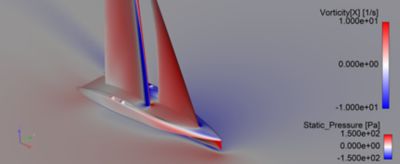-
-
Software gratuito per studenti
Ansys potenzia la nuova generazione di ingegneri
Gli studenti hanno accesso gratuito a software di simulazione di livello mondiale.
-
Connettiti subito con Ansys!
Progetta il tuo futuro
Connettiti a Ansys per scoprire come la simulazione può potenziare la tua prossima innovazione.
Paesi e regioni
Customer Center
Supporto
Partner Community
Contatta l'ufficio vendite
Per Stati Uniti e Canada
Accedi
Prove Gratuite
Prodotti & Servizi
Scopri
Chi Siamo
Back
Prodotti & Servizi
Back
Scopri
Ansys potenzia la nuova generazione di ingegneri
Gli studenti hanno accesso gratuito a software di simulazione di livello mondiale.
Back
Chi Siamo
Progetta il tuo futuro
Connettiti a Ansys per scoprire come la simulazione può potenziare la tua prossima innovazione.
Customer Center
Supporto
Partner Community
Contatta l'ufficio vendite
Per Stati Uniti e Canada
Accedi
Prove Gratuite
ANSYS BLOG
October 31, 2022
A New Cloud is on the Horizon: Introducing Ansys Gateway Powered by AWS
Cumulus. Stratus. Cirrus. All of us learned these cloud types at some point in elementary or middle school science class — and experienced a sudden realization that not all cloud formations were the same. For at least a few weeks or months, it changed how we looked up at the sky, seeing distinctions and variations we’d missed before. It turned out that the concept of a “cloud” was a lot more complex than we’d originally thought.
Similarly, the concept of cloud computing has grown in nuance and complexity since the term was first used in 1993 to describe the use of a distributed computing platform. Today there’s general agreement that there are three types of clouds: private, public, and hybrid. But within each of these three general classifications, there are seemingly endless cloud variations. Who owns the resources? How are they shared and accessed? How much control does the user have in specifying and controlling those resources?
Today, every organization seems to have a different answer. And, as companies become more digitally sophisticated, they’re demanding even more customized cloud approaches and configurations that meet their own unique computing needs — including the need for remote users to collaborate via cloud platforms.
Cloud providers are responding by delivering ever-increasing levels of flexibility, scalability, ease of use, and other service innovations — and with good reason: The global market for cloud computing is expected to grow from $405 billion in 2022 to nearly $1.5 trillion by 2028, reflecting an annual growth rate of 23.9%. Capturing a share of this market means understanding and meeting organizations’ changing requirements — and delivering more innovative, custom-tailored approaches to offering data storage, processing resources, and even shared virtual workspaces on demand.
Enabling Increased Control and Customization for Simulation Users
With its enormous data volumes and computational complexity, engineering simulation is ideally suited to a cloud computing environment. By distributing today’s large system-level, multiphysics problems over multiple remote processors, engineers can arrive at high-fidelity solutions faster than ever. Cloud-computing approaches deliver these rapid solution times in a cost-effective manner by enabling product development teams to minimize technology ownership and maintenance demands while still accessing state-of-the-art hardware resources and the newest software functionality.
In addition to the existing managed-services solution that has already helped hundreds of Ansys customers, there is a new Ansys cloud solution on the horizon. In response to customers’ evolving needs for more customized cloud platforms, which provide individual users with more control over the specific cloud configuration and easier collaboration, Ansys recently announced the availability of Ansys Gateway powered by AWS.
Ansys Gateway powered by AWS is an intuitive, scalable, easy-to-use cloud solution available via AWS Marketplace. After customers subscribe and complete a series of onboarding steps, they can deploy and scale Ansys applications on a virtual desktop infrastructure (VDI) or high-performance computing (HPC) cluster via the Ansys Gateway web portal.
Instead of committing to a static, resources-constrained, on-premises HPC platform or fixed software-as-a-service (SaaS) licensing agreement, customers can leverage their own AWS subscription and their own software licenses. By logging onto the Ansys Gateway powered by AWS web portal, they can easily initiate a simulation run of any size, from anywhere and at any time.
“We recognized that many organizations are already using AWS to manage their growing data volumes and processing needs,” says Neehar Kulkarni, Product Manager for Ansys Cloud Solutions. “They may not want to add another cloud platform just for simulation. As its name suggests, Ansys Gateway powered by AWS is designed to be a user-friendly gateway, or portal, that enables our customers to easily leverage the enormous computing power of AWS for all their Ansys simulation needs.”
The open architecture of Ansys Gateway powered by AWS enables Ansys software to run side-by-side with third-party CAE and CAD solutions. Product development teams can boost their engineers’ productivity by eliminating the need to switch back and forth between platforms as they complete analysis tasks and move on to the next step.
Ansys Gateway also improves engineering productivity, collaboration, and innovation by enabling each engineering team to create and manage its own virtual project space. Team members around the world can easily work together in this space by accessing the AWS resources closest to them. By acting as a platform for easy collaboration, the virtual project spaces delivered by Ansys Gateway powered by AWS reflect the way product development teams are working together today. AWS is a critical part of the equation because it streamlines the collaborative process and simplifies the complexity of bringing together geographically scattered team members.
“Helping customers get the most out of their Ansys simulation, we worked with Ansys on Ansys Gateway powered by AWS to boost innovation, accelerate time to market, and realize greater cost efficiencies. As a result of these efforts, customers now have a very secure, reliable, and accurate product that will push the boundaries of simulation,” says Avi Kulkarni, Senior Partner Development Manager at AWS.
Ansys Gateway powered by AWS also addresses evolving Ansys customer needs by enabling complete customization of the remote simulation processing environment. “We’ve noticed that our customers are becoming more tech-savvy about HPC and cloud,” says Krishna Samavedam, Senior Cloud Product Manager, Ansys. “With that knowledge comes a desire for greater control of the HPC resources.
“Ansys Gateway powered by AWS offers a nice balance between customization and ease of use. It’s flexible enough for power users or cloud-savvy users — but simple enough for those users who just want to ‘plug and play,’” adds Samavedam. “Even non-experts can quickly and easily configure, then iteratively reconfigure, an optimal VDI or HPC environment. They can see recommended virtual-machine configurations from Gateway and understand how these choices will impact their simulation run times upfront, before committing.”
Jim Burnham, Strategic Partnerships Director for Ansys, emphasizes that, no matter which VDI or HPC resources users select, they always have access to the most recent software features and functionality from Ansys, as well as the most advanced hardware, delivered by AWS.
“The world’s leading financial institutions, health care providers, and corporations are running on AWS today,” Burnham notes. “So extreme power, speed, and security are a given. It’s a partnership that makes sense for Ansys customers for many reasons.”
Tested, Proven Performance for Critical Simulations
While Ansys Gateway powered by AWS is a new offering, its fast and reliable performance has already been demonstrated by some of Ansys’ most demanding customers. Emirates Team New Zealand, an Ansys power user, applies both Ansys Fluent and Ansys Mechanical to optimize the designs of its winning America’s Cup yachts, both above and below the water.

Emirates Team New Zealand, uses Ansys simulation software to optimize the designs of its winning America’s Cup yachts via detailed simulations that are perfect candidates for Ansys Gateway powered by AWS.
The team’s detailed simulations, which include dynamic changes in wind and weather conditions, as well as sail shapes, can exceed 50 million cells. Because the size was putting a strain on its internal computing cluster, Emirates Team New Zealand partnered with Ansys to test the ability of Ansys Gateway powered by AWS to supplement the team’s on-premises HPC resources during peak usage periods.
“We were surprised by how easy and seamless it is to switch from our internal cluster to the cloud with Ansys Gateway powered by AWS,” notes Steve Collie, Aerodynamics Coordinator for Emirates Team New Zealand. “We can quickly set up a customized workstation or cluster and select the best hardware. We can replace our hardware every day if we want, instead of replacing physical resources every four years. It’s fast and intuitive to switch back and forth from cluster to cloud as our needs change.”
While its internal HPC cluster provides Emirates Team New Zealand with a good baseline computing resource, Ansys Gateway powered by AWS and Amazon EC2 Hpc6a instances powered by 3rd gen AMD EPYC™ processors provides instant and elastic additional capacity when Emirates Team New Zealand engineers are exploring computationally intense problems such as turbulence and cavitation, or running multiple simulations simultaneously.

Emirates Team New Zealand simulations can exceed 50 million cells. Ansys Gateway powered by AWS lets them switch from their internal cluster to the cloud and back.
According to Collie, Emirates Team New Zealand has realized important strategic benefits since switching to a hybrid computing approach.
“Now Emirates Team New Zealand is able to scale up on demand to many times the simulation throughput of our internal cluster, simply by switching over to Ansys Gateway powered by AWS. As a result, we can significantly accelerate our design for the 2024 America’s Cup.”
Whether Ansys customers are relying on Ansys Gateway powered by AWS to manage all their simulation needs or taking a hybrid approach like Emirates Team New Zealand, they now have a robust new cloud services model, powered by AWS, to accelerate and streamline their most computationally intense product studies. By scaling up their computing capabilities via an easy-to-use cloud platform, every product development team can keep the wind in its sails, taking a decisive lead in the race to meaningful innovation and market leadership.